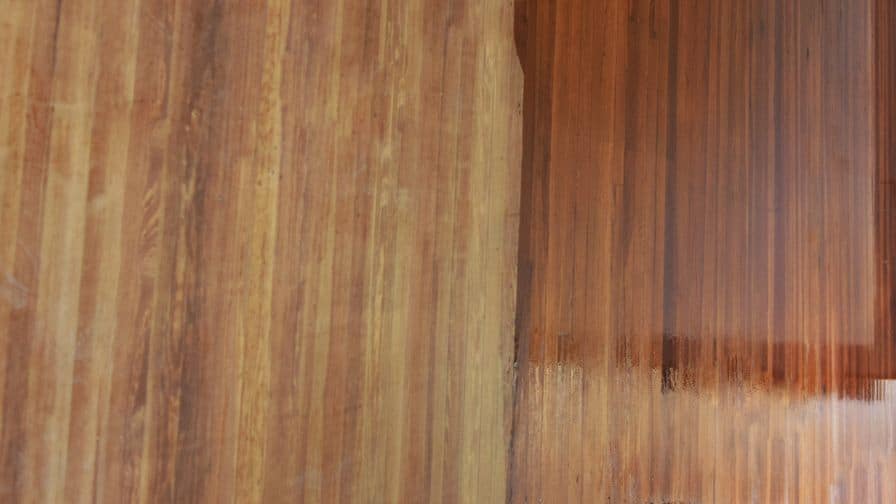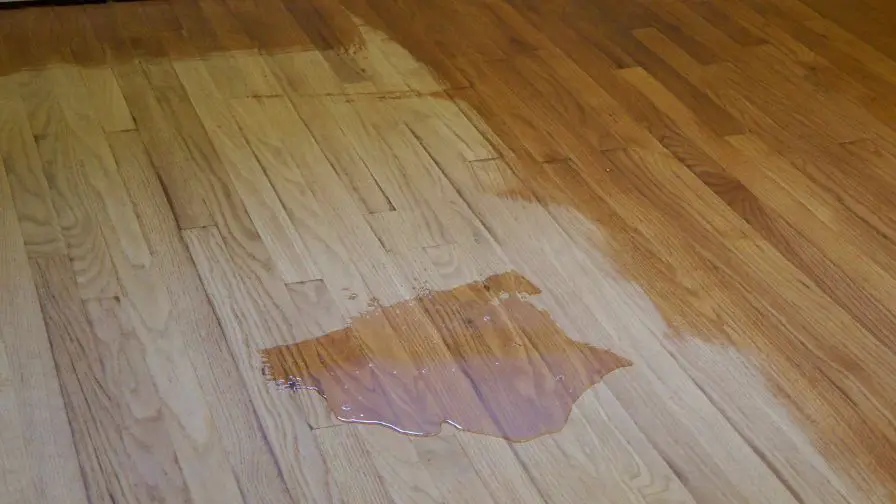
Do you have a piece of furniture that you finished with polycrylic and now you want to remove it? It can become tricky to know how to do it properly. In this blog post, we will walk you through the step-by-step process of removing polycrylic from wood.
We’ll give you some tips on how to make the process easier, and we’ll also let you know what to watch out for. So, if you’re ready, let’s get started!
Table of Contents
What Is Polycrylic And Why Would You Want To Remove It
Polycrylic is a type of water-based polymer. It acts as a sealer or topcoat for wood projects because it dries clear and protects the surface from scratches, stains, and fading. Polycrylic can be applied with a brush, roller, or sprayer.
You may want to remove polyacrylic because it has yellowed, is peeling, or you simply don’t like the way it looks. Removing polycrylic is fairly simple and can be done with a few household items.
The Step-By-Step Process Of Removing Polycrylic
To remove polyacrylic, you will need:
-Rubbing alcohol
-Abrasive pad or sandpaper
-Paint stripper
-Paintbrush
-Putty knife
-Cloth
-Mineral spirits
Now that you have your supplies, it’s time to get started! The first step is to make sure that the surface you’re working on is clean and free of any debris. Once you did that, you can start by applying a generous amount of stripper to the area with a paintbrush.
After letting the stripper sit for a while, you can start scraping away at the polycrylic with a putty knife. Do this carefully so as not to damage the surface beneath. Once you remove as much of the polycrylic as possible, you can wipe down the area with a cloth soaked in mineral spirits.
That’s it! With a little patience and elbow grease, you can remove polycrylic from any surface. Take the necessary precautions and work in a well-ventilated area.
Subscribe to Greenrumour on YouTube
Tips For Making The Process of Removing Polycrylic Easier
There are a few things you can do to make the process of removing polycrylic easier.
First, make sure that you have all the necessary tools and materials.
Second, follow the directions carefully.
Third, show patience and take your time.
Fourth, use a putty knife or another sharp tool to scrape off any excess polyacrylic.
Fifth, use a clean cloth to wipe away any residue.
Finally, if you’re still having trouble removing the polycrylic, you can always sand it off. With these tips in mind, you should remove polycrylic with ease.
What To Watch Out For When Removing Polycrylic
When removing polycrylic finish, there are a few things you need to watch out for.
First, make sure that you are wearing gloves and eye protection.
Second, practice caution with the chemicals you are using. Make sure to read the labels carefully and follow the instructions.
Third, when sanding the surface, use a respirator or dust mask to avoid inhaling the fumes.
Lastly, take your time and work in a well-ventilated area to avoid any accidents.
Removing polycrylic finish can become a tricky process. But following these simple tips will help you get the job done safely and efficiently.
Will Polycrylic Wash Off?
If you’re working with polycrylic and you’re wondering if it will wash off, the answer is no.
Polycrylic is a water-based product, so it’s not going to wash off in the rain or anything like that. However, it is possible to remove polycrylic with mineral spirits or paint thinner.
So, if you’re trying to remove it from your hands or clothes, you’ll need to use one of those solvents. Otherwise, polycrylic is a tough product and it should last for a long time.
How Do You Clean Polycrylic?
Polycrylic is a synthetic resin that serves as a clear coat for finishes on wood. It is tough and durable, making it ideal for high-traffic areas. Polycrylic can be cleaned with mild soap and water. You can also use a commercial cleaner specifically designed for polycrylic.
To clean polycrylic, start by dusting the surface with a soft cloth. If there is any stubborn dirt or grime buildup, you can use a mild soap and water solution. Rinse the surface well and dry it with a clean cloth afterward. For tougher stains, you can use a commercial polycrylic cleaner. Always follow the manufacturer’s instructions when using any type of cleaner.
Polycrylic is a durable finish, but harsh chemicals or abrasive cleaners can still cause damage. Avoid using anything that might scratch or dull the surface.
Can Polycrylic Be Sanded?
You can sand polycrylic. However, there are a few things to keep in mind when sanding this type of finish.
Polycrylic is a durable and clear finish that is on wood surfaces a lot. It can become confusing to sand because it dries quickly and can gum up sandpaper. Use fine-grit sandpaper and work in small sections. You should also avoid using a power sander because it can create too much heat and damage the polycrylic finish.
If you need to remove polycrylic from a wood surface, sanding is the best way to do it. However, you need to have caution so as not to damage the wood.
Can You Paint Over Polycrylic Without Sanding?
Yes. However, remember a few factors before you start painting.
First, make sure the polycrylic is completely dry. If it’s even slightly damp, the paint will have a hard time adhering to the surface.
Second, use a high-quality primer designed for glossy surfaces. This will help the paint stick to the polycrylic and prevent peeling or chipping down the road.
Finally, don’t skimp on the paint job itself. Use high-quality paint designed for durability. This will ensure that your paint job lasts for years to come.
With these tips in mind, you can successfully paint over polycrylic without sanding.

How To Remove Polycrylic From Glass
You can remove polyacrylic from glass by using a razor blade. First, score the polyacrylic with the razor blade to create channels for the solvent to travel. Next, use a paint stripper or other solvent to wet the scored polyacrylic. Finally, scrape the softened polyacrylic from the glass using the razor blade.
If you’re having trouble removing all of the polyacrylic, you can try using a heat gun or hair dryer to soften the material. Be careful not to overheat the glass, as this could cause it to break. Once the polyacrylic is softened, you should be able to scrape it off with a razor blade.
If you’re still having trouble removing the polyacrylic, you can try using a sandblaster or other abrasive tool to remove it. Just be sure not to damage the glass beneath the polyacrylic.
Here are a few tips to help you remove polycrylic from glass:
– Use a razor blade or putty knife to scrape off as much of the dried polycrylic as possible.
– Apply mineral spirits or paint thinner to a clean rag and wipe away any remaining residue.
– If there are still stubborn streaks, try using a window cleaner or vinegar and water solution.
With these tips, you should remove polycrylic from the glass without any problem.
How To Remove Polycrylic From Metal
Stripping paint and finishes from metal surfaces can become a real challenge. If you’re trying to remove polycrylic from metal, there are a few things you can do to make the process easier.
First, try using a chemical stripper. The design is to break down and remove paint, varnish, and other finishes from surfaces. They come in both liquid and gel forms. So you can choose the one that will work best for your project!
Once you apply the stripper, give it time to work according to the manufacturer’s instructions. After that, you should remove the polycrylic with a putty knife or other scraping tool.
If the chemical stripper doesn’t do the trick, you can try sanding. This will take more effort on your part. But it’s worth a shot if you’re trying to avoid damaging the metal surface.
Start with medium-grit sandpaper and work your way up to a finer one. Sand in the direction of the grain to avoid scratches.
Does Acetone Remove Polycrylic
Yes, acetone will remove polycrylic from surfaces like wood and metal. However, it’s important to note that acetone is a powerful solvent that can damage some finishes and surfaces. That’s why it’s always best to test a small area before using acetone to remove polycrylic from your project piece.
What Is A Chemical Paint Stripper?
Most paint strippers are either caustic (alkaline) or corrosive (acidic). Caustic strippers contain lye or sodium hydroxide and work by breaking down the molecular bonds that hold the paint to the surface. Corrosive strippers, on the other hand, use acid to dissolve the paint. The most common corrosive strippers are hydrochloric acid and phosphoric acid.
Liquid strippers are more difficult to control and can run off surfaces with the incorrect application. Gel strippers, on the other hand, are thicker and easier to apply. However, paint strippers should only serve as a last resort.



